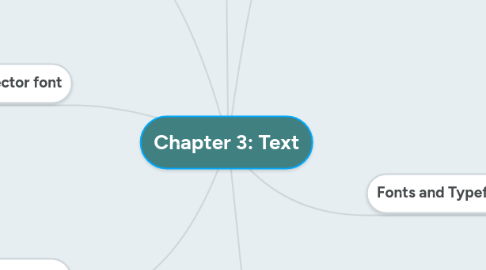
1. Text elements
1.1. Menus for navigation
1.1.1. user navigates through content using a menu.
1.2. Interactive buttons
1.2.1. A button is a clickable object that executes a command when activated
1.3. Fields for reading
1.3.1. Reading a hard copy is easier and faster than reading from the computer screen.
1.4. HTML documents
1.4.1. HTML stands for Hypertext Markup Language
1.5. Symbols and icons
1.5.1. Icons
1.5.1.1. are symbolic representations of objects and processes
1.5.2. Symbols
1.5.2.1. A symbol represents products or ideas.
2. Choosing text fonts
2.1. Consider legibility and readability.
2.2. Avoid too many faces.
2.3. Use color purposefully.
2.4. Use anti-aliased text.
2.5. Use drop caps and initial caps for accent
2.6. Minimize centered text
2.7. Use white space.
2.8. Use animated text to grab attention.
3. Bitmap font and Vector font
3.1. Bitmap
3.1.1. Bitmaps font consist of a matrix of dots or pixels representing the image.
3.2. Vector
3.2.1. Vector fonts drawing use instructions and mathematical formulae to describe each glyph.
4. Character sets
4.1. ASCII (American Standard Code for Information Interchange)
4.1.1. character is represented by a unique 7-bit binary code word
4.2. Extended Character Set (ISO Latin-1)
4.2.1. Extra 1 bit in ASCII –up to 256 characters
4.3. Unicode
4.3.1. Unicode is a 16-bit architecture for multilingual text and character encoding
4.3.2. Unicode can support a wide variety of non-Roman alphabets including Han Chinese, Japanese, Arabic, Korean, Bengali, and so on
5. Hypertext vs Hypermedia
5.1. Hypertext
5.1.1. Hypertext is a text which contains links to other texts.
5.2. Hypermedia
5.2.1. Hypermedia is not constrained to be text-based.
5.2.2. Hypermedia Structure
5.2.2.1. The simplest way to navigate hypermedia structures is via buttons.
5.2.2.2. Links
5.2.2.2.1. Links are connections between conceptual elements
5.2.2.3. Nodes
5.2.2.3.1. Nodes are accessible topics, documents, messages, and content elements.
5.2.2.4. Anchors
5.2.2.4.1. An anchor is defined as the reference from one document to another document, image, sound, or file on the Web.
6. Importance of Text
6.1. The simplest of data types
6.2. Form of symbols, words, sentences, and paragraphs
6.3. Vital element of multimedia menus, navigation systems, and content
7. Fonts and Typefaces
7.1. Typeface
7.1.1. a family of graphic characters, often with many type sizes and styles
7.2. Font
7.2.1. a collection of characters of a single size and style belonging to a particular typeface family
7.2.2. Font styles
7.2.2.1. Boldface
7.2.2.2. Italic
7.2.2.3. Underlining
7.2.2.4. Outlining
7.2.3. Font Terminology
7.2.3.1. Baseline
7.2.3.1.1. the line on which the bases of characters are arranged
7.2.3.2. Cap height
7.2.3.2.1. cap height refers to the height of a capital letter
7.2.3.3. x-height
7.2.3.3.1. the distance between the baseline and the top of a lower-case letter x
7.2.3.4. Ascenders/descenders
7.2.3.4.1. strokes that rise above the x-height/drop below the baseline
7.2.3.5. Kerning
7.2.3.5.1. adjustment of space between certain pairs of letters to make them look more uniform
7.2.3.6. Tracking
7.2.3.6.1. adjustment of space for groups of letters
7.2.4. Serif versus sans serif
7.2.4.1. Serif
7.2.4.1.1. little decoration at the end of a letter stroke.
7.2.4.1.2. fonts are used for printed media or documents that have large quantities of text.
7.2.4.2. Sans serif
7.2.4.2.1. fonts do not have decoration at the end of a letter stroke
7.2.4.2.2. fonts are used for headlines and bold statements. It is considered better for computer displays.
7.3. Cases
7.3.1. Capitalized letter is referred to as uppercase, while a small letter is referred to as lowercase
7.3.2. Placing an uppercase letter in the middle of a word is referred to as an intercap or CamelCase

